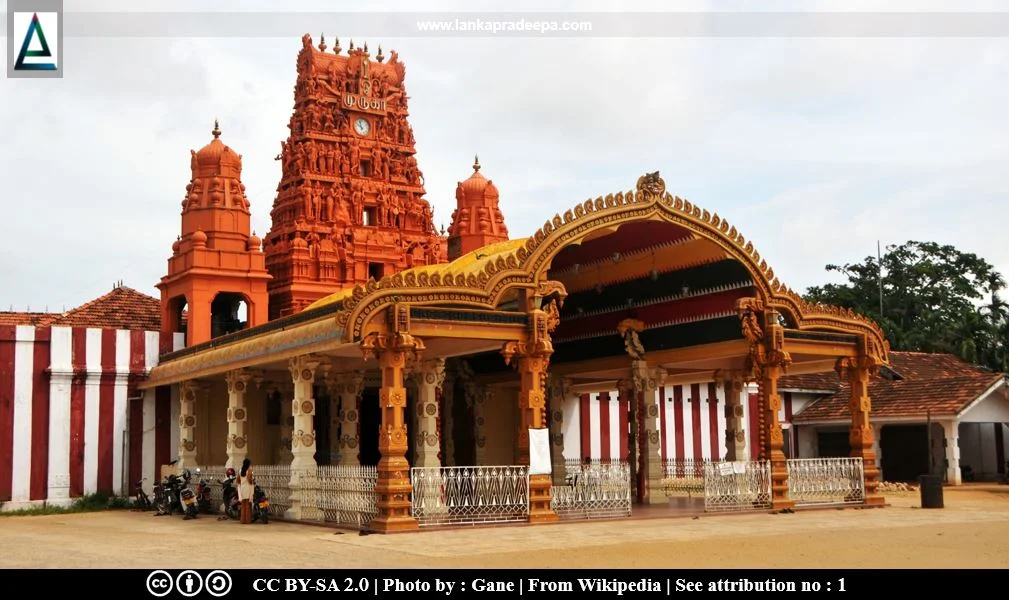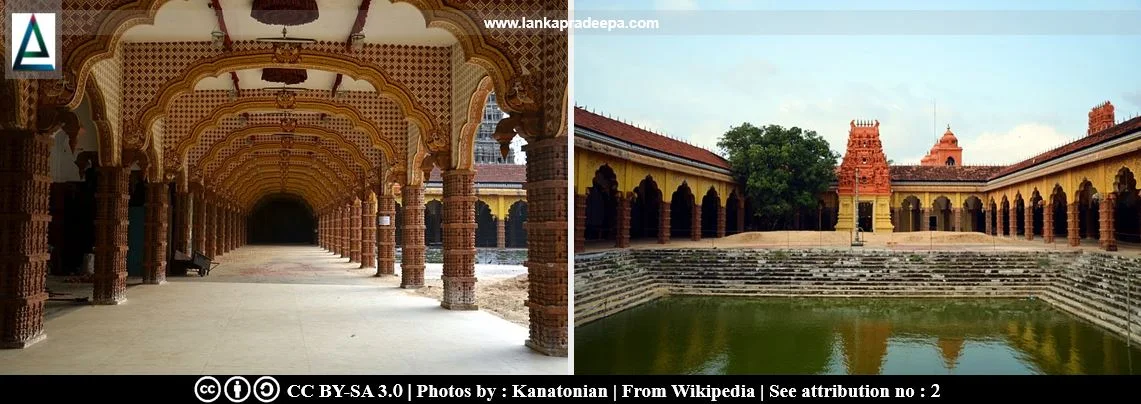
Nallur Kandaswamy Temple (Tamil: நல்லூர் கந்தசுவாமி கோவில்; Sinhala: නල්ලූර් කන්දසාමි කෝවිල, ස්කන්ධ කුමාර කෝවිල) is a Hindu Kovil situated in Nallur in Jaffna District, Sri Lanka. It is dedicated to Lord Murugan (or God Kataragama), the War God of the Hindu pantheon.
History
The chronicle Mahavamsa identifies this place as Beejagama (Dias et al., 2016). According to S. Paranavitana, a substantial amount of Buddhist activities had taken place here (Dias et al., 2016).
The author of Yalpana Vaipava Malai (a text of 18-19th century) mentions that a Chola prince named Vijaya Kulangai (or Kulang-kay-ariyan or Singka-ariyan) accepted the regency of Sri Lanka on a request made by Malavan of Vellala lineage from the Pandya state of India (Britto, 1879; Dias et al., 2016). It is said in the text that they set out to build the Nallur city by constructing parapets, mansions etc. (Britto, 1879; Dias et al., 2016). Ponds were also constructed and the water of them is said to have been purified by mixing it with the water brought from the Yamuna River in India [(see Yamuna Eri) Britto, 1879; Dias et al., 2016].
Old Kandaswamy temple
In the middle of the 15th century, Sapumal Kumaraya (Sempahapperumal in Tamil), the adopted son of King Parakramabahu VI (c.1412–1467 A.D.) of the Kotte Kingdom, reigned in Jaffna as the viceroy under his father (Sabanathan, 1971). He, before ascending the throne of the country under the royal title King Buvanekabahu VI (1469-1480 A.D.), built a temple in Jaffna and dedicated it to God Kataragama (Sabanathan, 1971). That temple is believed to be the most ancient temple of the present Kandasamy temple in Nallur (Wijebandara, 2014). The name of Buvanekabahu is presently included in the Kattiyam or the invocation of blessings on the founder of the Kandasamy temple (Sabanathan, 1971).
The Jaffna kings or Arya Chakravartis who came from South India are said to have built four temples around the main Kandaswamy temple, namely, Veilugantha Pillaiyar Temple (east), Veeramakali Amman Temple (west), Sattanathar Temple (north), and Kailaya Nathar temple [(south) Sabanathan, 1971].
Destruction
The temple, however, confronted the threat of destruction by the Portuguese who occupied Jaffna for the first time in 1560. In 1621, the Portuguese general Filipe de Oliveira destroyed the temple and built a Catholic church there (Navaratnam, 1964; Sabanathan, 1971; Sarma, 2007; Wijebandara, 2014). The church located near the present Sangilian Thoppu is believed to be that church built by the Portuguese (Wijebandara, 2014).
Modern Kandaswamy temple
In 1658, the Jaffna fell under the rule of the Dutch (Wijebandara, 2014). The modern Kandasamy temple was built at the present location by Don Juan Ragunatha Mappana Mudaliyar (an officer of the Jaffna Kachcheri under the Dutch Government) in 1734 (Sabanathan, 1971; Wijebandara, 2014). It was later developed to the present state by Kumaradasa Mappana Mudaliyar (Wijebandara, 2014).
 .
.Attribution
References
1) Britto, C., 1879. The Yalpana-Vaipava-Malai or The history of the Kingdom of Jaffna: Translated from the Tamil, with an appendix and a glossary by C. Britto. Colombo. p.14.
2) Dias, M.; Koralage, S.B.; Asanga, K., 2016. The archaeological heritage of Jaffna peninsula. Department of Archaeology. Colombo. pp.195-197.
3) Navaratnam, C.S., 1964. A short history of Hinduism in Ceylon; And three essays on the Tamils. Sri Sanmuganatha Press. p.79.
4) Sabanathan, M.K., 1971. Nallur Kandaswamy Temple. Inthusathanam (The Hindu Organ). 23 July 1971. pp.5,7.
5) Sarma, B.S., 2007. History of Munneswaram Temple. Sri Sankar Publications. p.21.
6) Wijebandara, I.D.M., 2014. Yapanaye Aithihasika Urumaya (In Sinhala). Published by the editor. ISBN-978-955-9159-95-7. pp.122-125.
Location Map
This page was last updated on 18 November 2022

